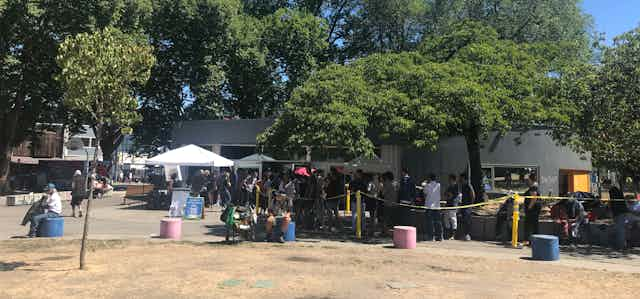The hottest summer ever recorded in the northern hemisphere is a stark reminder of the immediacy of the climate crisis. And the hardest hit by climate impacts, such as residents of Vancouver’s Downtown Eastside, are often those with the least capacity to adapt.
People who live in this community are exposed to climate hazards made worse by a lack of green space and shoddy and aging housing. Residents experience the cumulative impacts of factors such as the opioid epidemic, poverty, limited employment opportunities, intergenerational trauma and criminal justice and mental health issues.
As a result, residents have had little space for participation in climate adaptation policy. But when climate shocks occur, this community is disproportionately at risk.
In times like these, people need clear advice, and access to knowledge that allows them to have a voice in policymaking. However, the often-opaque research on climate impacts, hallmarked by inaccessible language and exclusionary methods of communication, do little to help those most affected.
It is of urgent importance that universities live up to their stated desires for impact and work directly with the most vulnerable populations on the front lines of the climate crisis.
Climate change impacts
The Downtown Eastside is the historic heart of Vancouver consisting of seven adjoining yet distinct neighbourhoods with a total population of 18,500. A changing climate has a heightened impact on residents due to several intersecting challenges.
During a heat wave, urban tree canopy and access to nature can be lifesaving public goods. Highly paved areas can be as much as 12֯ C hotter than areas with an urban tree canopy due to the urban heat island effect.

While much of Vancouver enjoys significant cover, the Downtown Eastside is the least forested part of the city. This lack of trees worsened the neighbourhood’s extra high temperatures during the deadly 2021 heat dome. To address the loss of trees through densification and urbaniziation, Vancouver has a tree protection bylaw and an Urban Forest Strategy that sets targets on tree canopy for the city.
The unhoused population also faces a risk of heat-related mortality up to 200 times greater than those with access to shelter. Chronic housing precarity in the neighbourhood far exceeds anywhere else in the city.
Disproportionate risk is also borne by individuals living with chronic health conditions such as substance use disorder, schizophrenia, and mood or anxiety disorders. The provincial “Death Review Panel” found that 91 per cent of the more than 600 lives lost during the 2021 Vancouver heat dome were individuals with at least one chronic disease.
Read more: 'Statistically impossible' heat extremes are here – we identified the regions most at risk
Too often research on disproportionate climate impacts like this fails to reach those most affected. Purposeful collaboration with these populations needs to be respectfully sought in determining the direction, execution and communication of research. Researchers need to take the time to make their practices more accessible and connected to community-driven climate research needs.
Overcoming barriers
The urgency of the climate emergency accelerates the need for research to be translated into policy. A crucial step lies in universities such as the University of British Columbia seeking out opportunities to work more closely with climate-vulnerable groups.
Residents deserve access to research on climate impacts and a voice in advocating for fairer climate policies. Making climate research easier to access and understand can set the conditions for transformative adaptation and help build resilience.
Tools such as graphic visualisations can help increase community engagement in decision-making. Researchers should think about who will use the information, seek out their involvement early on, and find accessible ways to communicate findings.

University staff dedicated to knowledge exchange, community climate partnerships, and applied research internships — as well as satellite “learning exchange” offices — can help busy faculty make climate research accessible.
Centres of change and empowerment
As trusted sources of knowledge, universities have a key role to play in addressing this communication gap. The UN Secretary General has pointed out that universities are “essential to our success” on climate action. Naomi Klein, co-director of UBC’s Centre for Climate Justice, notes that universities can boost the influence of marginalized communities in policy responses by emphasizing equity and justice in climate research and communication.
Impact, dissemination and knowledge exchange are university buzzwords, but it is still rare for researchers to work directly with the most vulnerable populations. Collaborating on all aspects of research, from design to presentation, empowers at-risk communities to co-create, access and advocate for adaptive climate policies that meet their priorities.
UBC’s 2019 Climate Emergency Declaration commits the university to build just and inclusive climate solutions that work towards dismantling historic and existing barriers faced by marginalized communities.
For these commitments to be fully realized and reflected in policy outcomes, climate research needs to be accessible and actionable. Amplifying underrepresented voices will improve climate policies and outcomes. Together, we can create a more equitable neighbourhood and a more resilient city.

